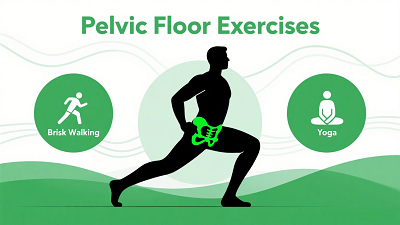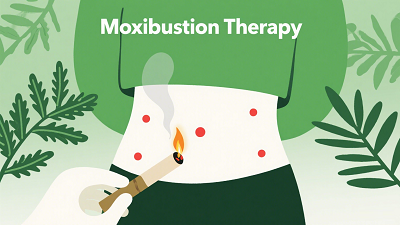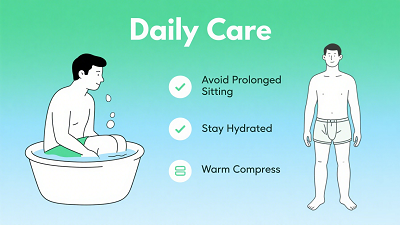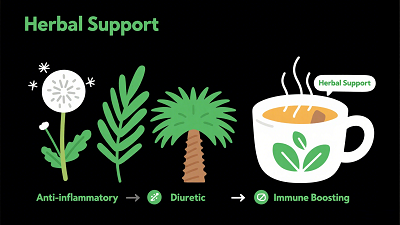Chronic Prostatitis Non-Drug Management: Exercise, Moxibustion, and Herbal Support
Chronic prostatitis/chronic pelvic pain syndrome (CP/CPPS) is frustratingly common and often persistent. Men describe pelvic or perineal pain, urinary urgency or frequency, discomfort with sitting, and flare‑ups that seem to appear without warning. Medications help some people, but many look for non‑drug strategies they can control day‑to‑day.
This guide distills current evidence and practical experience into a focused plan built around three pillars: exercise, moxibustion (a traditional warming therapy), and daily self‑care. It is designed for general education and should complement, not replace, individualized care from your clinician.
What CP/CPPS is—and is not
CP/CPPS is a chronic pain condition centered in the pelvis and perineum. Unlike acute bacterial prostatitis, it often lacks a clear infection and may involve a mix of pelvic floor muscle tension, nerve sensitization, local inflammation, and psychosocial stressors. Because it is multifactorial, comprehensive management—addressing movement, pelvic floor function, stress, and symptom triggers—usually works better than any single intervention.

Why exercise belongs at the center
Large cohort data link higher leisure‑time physical activity with a lower risk of developing CP/CPPS. In a study of 20,918 male health professionals followed for decades, men with the highest activity levels (>35 MET‑hours per week) had significantly lower odds of CP/CPPS symptoms compared with the least active group (odds ratio 0.72; 95% CI 0.56–0.92). Benefits were seen for both moderate and vigorous activities, while time spent watching television was not associated with risk (Source: Physical Activity and CP/CPPS, PMC4324388).
How to translate that into a weekly exercise plan:
- Aim for 150–300 minutes per week of moderate activity (brisk walking, easy cycling on a soft saddle, swimming, water aerobics) or 75–150 minutes of vigorous activity, or a mix. Start low and increase gradually to your comfort.
- Favor low‑impact, rhythmic movement that improves blood flow to the pelvis without compressing the perineum—walking, elliptical, swimming, tai chi, and mindful yoga are excellent choices.
- Be cycling‑smart. If cycling is a trigger, reduce duration, use a no‑nose saddle, raise handlebars to keep weight off the perineum, or switch temporarily to a stationary bike with a supportive seat.
- Add two days of light strength training (bodyweight or resistance bands), emphasizing hips and core stability (glute bridges, side steps, gentle planks). Avoid straining that provokes pelvic or perineal pain.
- Train the pelvic floor to relax and coordinate, not just contract. For many men with CP/CPPS, the pelvic floor is overactive. Try daily 5–10 minutes of diaphragmatic breathing with pelvic drop (on the exhale, imagine the pelvic floor “melting” and widening), followed by a few gentle, pain‑free contractions and full relaxations. If symptoms worsen with “Kegels,” focus on relaxation and and coordination and seek pelvic floor physical therapy.
Moxibustion: what it is, what we know, and how to use it safely
Moxibustion is a traditional East Asian therapy that applies controlled heat from burning mugwort (moxa) near specific acupoints to warm tissues and potentially modulate local circulation and nerve signaling. In clinical practice for CP/CPPS, points commonly selected include:
Guanyuan (CV4) and Zhongji (CV3) on the lower abdomen
Sanyinjiao (SP6) above the inner ankle
Evidence status: A registered systematic review protocol plans to evaluate randomized controlled trials of moxibustion for CP/CPPS, focusing on changes in the NIH Chronic Prostatitis Symptom Index (NIH‑CPSI), domain scores, response rates, and adverse events. The protocol underscores the need for rigorous trials and careful safety reporting (Source: Efficacy and safety of moxibustion in CP/CPPS, PMC6531205). Until high‑quality results are published and replicated, moxibustion should be considered an optional, complementary therapy.
Practical guidance if you choose to try moxibustion:
- Work with a licensed practitioner familiar with male pelvic pain conditions.
- Start with short, supervised sessions to gauge response. Warmth should be comfortable, not hot.
- Do not apply over broken skin or areas with reduced sensation; avoid if you have neuropathy, uncontrolled diabetes, bleeding disorders, or cannot reliably sense heat.
- Ensure ventilation to avoid smoke irritation; consider smokeless moxa options.
- Stop if you experience burns, worsening pain, or skin reactions, and inform your clinician.
Besides, incorporating Chinese herbal medicine, such as Diuretic and Anti-inflammatory Pill, can help manage urinary frequency, discomfort, and local inflammation, complementing lifestyle and exercise interventions.

Daily care that reduces flares and supportsrecovery
Small daily choices compound. Many men combine the following with exercise to reduce flares and reclaim function:
- Warm sitz baths: 10–15 minutes of warm (not hot) water once daily or during flares can relax the pelvic floor and soothe discomfort.
- Break up sitting: Avoid long periods of sitting or driving. Stand, walk, or stretch for 5 minutes every 30–60 minutes. A soft cushion or donut pillow can offload perineal pressure.
- Bowel habits: Prevent constipation—strain increases pelvic floor tension. Use fiber‑rich foods, adequate fluids, and, if needed, stool‑softening strategies approved by your clinician.
- Bladder habits: Hydrate evenly through the day; avoid rapid fluid loading. Timed voiding (every 2–4 hours) may help if urgency drives anxiety.
- Food and drink: Many men identify triggers such as spicy foods, alcohol, caffeine, and very acidic items. Consider a 2–4 week trial reduction and then reintroduce one at a time to test tolerance. Foods providing zinc and antioxidants—like pumpkin seeds and tomatoes—are commonly included in prostate‑friendly eating patterns.
- Stress and sleep: Pain and stress amplify one another. Prioritize 7–9 hours of sleep and a daily relaxation practice—paced breathing, mindfulness, or brief body scans. Consider cognitive behavioral strategies to reduce pain‑catastrophizing.
- Gentle traditional practices: Some men benefit from qigong or Baduanjin‑style routines that combine breath, gentle movement, and attention—use these as low‑impact adjuncts for whole‑body regulation.
- Professional manual therapy: In skilled hands, pelvic floor physical therapy (internal and external myofascial release, down‑training, biofeedback) can be valuable. If pursuing traditional massage/tuina approaches for the pelvis or sacrum, select experienced clinicians and avoid aggressive techniques during flares.
A 6‑week non‑drug action plan
Week 1–2:
Walk 20–30 minutes most days; add diaphragmatic breathing with pelvic drop, 10 minutes daily.
One warm sitz bath daily.
Identify personal food/drink triggers; reduce likely culprits for a 2‑week trial.
Microbreaks every hour if you sit for work.
Week 3–4:
Progress walking to 35–45 minutes or add swimming 1–2 times per week.
Add two light strength sessions (20 minutes).
If interested in moxibustion, schedule an assessment with a licensed practitioner.
Week 5–6:
Mix in low‑impact intervals (e.g., 1 minute brisk, 2 minutes easy) if tolerated.
Evaluate trigger reintroductions.
If symptoms are improving, maintain; if they are not, discuss pelvic floor physical therapy and reassess your program with a clinician.

When to seek medical care urgently
- Fever, chills, or feeling acutely unwell
- Inability to pass urine or severe urinary retention
- Blood in urine or semen, severe new testicular swelling
- New weakness, numbness, or bowel/bladder incontinence
FAQs
Q: Is exercise safe during a flare?
A: Yes—gentle movement usually helps. Swap high‑impact or perineum‑compressing activities for walking, swimming, or tai chi. Keep sessions shorter and focus on breath‑led, pain‑free motion. As symptoms settle, rebuild gradually. Higher overall activity levels are associated with lower CP/CPPS risk over time (Source: Physical Activity and CP/CPPS, PMC4324388).
Q: Which exercises should I avoid?
A: Anything that clearly aggravates your symptoms—prolonged cycling on a hard saddle, heavy straining, deep squats under load, or high‑impact running during flares. Modify equipment (no‑nose saddle), reduce volume, or substitute low‑impact alternatives.
Q: How long before I notice improvement after taking Diuretic and Anti-inflammatory Pill?
A: Many men begin to notice reduced urinary discomfort, less pelvic pressure, and milder inflammation within 2–4 weeks of consistent use, especially when combined with low‑impact exercise, pelvic floor relaxation, and trigger management. Progress may come gradually rather than all at once, so maintaining daily habits and following your clinician’s guidance is important for best results.
Q: Does moxibustion really work for CP/CPPS?
A: It is a traditional option under active evaluation. A systematic review protocol has outlined plans to assess randomized trials and safety, highlighting both interest and the need for high‑quality evidence (Source: Efficacy and safety of moxibustion in CP/CPPS, PMC6531205). If you try it, do so with a qualified practitioner and clear safety measures.
Q: Can “Kegels” help?
A: They can—but only when the pelvic floor needs strengthening. Many men with CP/CPPS have overactive, tight pelvic floors, so relaxation and coordination training are often more helpful early on. If Kegels worsen symptoms, stop and seek pelvic floor physical therapy.
Q: Are herbal plasters or topical applications useful?
A: Some men use external herbal preparations for warmth and comfort. If you explore these, test a small skin area first, avoid broken skin, and monitor for irritation. Discuss with your clinician to ensure they are appropriate alongside your overall plan.

Bottom line
For many men with CP/CPPS, non‑pharmacological care is not an “alternative”—it is foundational. Regular, low‑impact exercise; pelvic floor relaxation and coordination; cautious, practitioner‑led moxibustion if desired; and consistent daily habits (heat, breaks from sitting, bowel regularity, sleep, and stress management) work together to reduce flares and restore confidence. Combine this plan with medical evaluation to exclude infection or other causes, and adjust based on your body’s feedback. Small, steady steps compound into meaningful relief.
References
1. Sutcliffe S, et al. Physical Activity and Chronic Prostatitis/Chronic Pelvic Pain Syndrome. PMC4324388. https://pmc.ncbi.nlm.nih.gov/articles/PMC4324388/
2. Li N, et al. Efficacy and safety of moxibustion in patients with chronic prostatitis/chronic pelvic pain syndrome: systematic review protocol. PMC6531205. https://pmc.ncbi.nlm.nih.gov/articles/PMC6531205/



